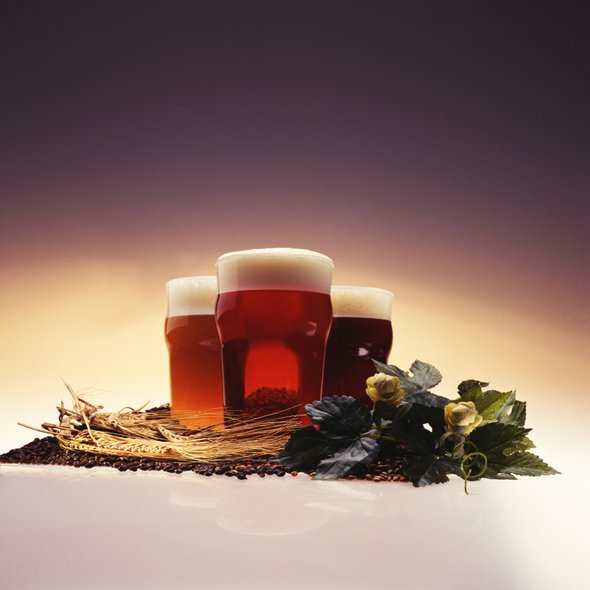(单词翻译:单击)
听力文本
This is Scientific American — 60-Second Science. I'm Christopher Intagliata.
The Allagash Brewing Company, in Maine, makes a lot of "bottle-conditioned" beers — brews that get their carbonation by fermenting a second time, in the bottle, as yeast belch out CO2.
"And because they do bottle conditioning they're meticulous about monitoring package pressures. It's a way for them to follow the progression of this re-fermentation in the bottle." Thomas Shellhammer is a brewing scientist at Oregon State University. Who freely acknowledges: "It's a fun job. Science and beer."
Anyway, not long ago, Allagash noticed some very high pressures in some of their bottles. Not quite exploding. But alarming enough for them to give Shellhammer a call.
What he and his colleague Kaylyn Kirkpatrick found was that hops — the bittering agent in beers — might be to blame. Because the aromatic flowers contain enzymes that can chew up starch. Typically, when hop flowers are added during the initial cooking of the fermentable brew, those key enzymes are denatured. And thus the flowers' only role is as a flavoring agent.
But as the demand for hoppy beers has grown, brewers have been looking for other tricks to get those juicy, fruity, herbal aromas into beers. So they've been what's called "dry-hopping" beers — dumping loads of hops into the beer during or after fermentation, rather than during the initial boil.
"So there's sort of an upward limit to how much hops you'd want to put in the kettle because the beers just get unpalatably bitter. But if a brewer focuses on dry hopping they can put very large amounts of hops into beer to create intense hoppy flavors."

Problem is, adding hops late doesn't deactivate their starch-attacking enzymes. And they're able to break down starches the yeasts weren't able to attack, unleashing even more sugar into the brew. And if yeast are still hanging out, as in Allagash's bottle-conditioned beers, that kickstarts additional fermentation. And that boosts alcohol by volume and carbon dioxide concentration — to potentially explosive levels.
"Basically the hops are taking something that's considered by brewers to be unfermentable, and breaking them down to the point where they can actually re-ferment, or become fermentable, or potentially contribute to sweetness, as beer ages."
The full detective story is in the Journal of Agricultural and Food Chemistry.
And, in case you're wondering, Shellhammer's palate does align with his academic interests: "I'm kind of intrigued by the hazy, juicy IPA thing that's going on right now. I'm also a fan of sort of traditional old school IPAs." He's the rare professor whose students use IPAs to raise their GPAs.
And, in case you're wondering, Shellhammer's palate does align with his academic interests: "I'm kind of intrigued by the hazy, juicy IPA thing that's going on right now. I'm also a fan of sort of traditional old school IPAs." He's the rare professor whose students use IPAs to raise their GPAs.
Thanks for listening for Scientific American — 60-Second Science Science. I'm Christopher Intagliata.
参考译文
这里是科学美国人——60秒科学。我是克里斯托弗·因塔利亚塔。
美国缅因州的阿拉加什酿酒公司生产大量的瓶装啤酒,随着酵母喷出二氧化碳,啤酒会通过在瓶中二次发酵而获得碳化作用。
“由于他们制造的是瓶内发酵啤酒,所以他们会仔细监测瓶子压力。对他们来说,这是追踪瓶中再发酵过程的一种方式。”俄勒冈州立大学的酿造学家托马斯·谢尔哈默说到。他坦率地承认:“这是份有趣的工作。既有科学,又有啤酒。”
总之,不久前阿拉加什公司注意到有些酒瓶内的压力非常高。压力并未达到爆炸的程度。但这足以令他们感到担忧,因此他们打电话将此事告知了谢尔哈默。
他和同事凯琳·柯克帕特里克发现,这可能要归咎于啤酒中的苦味剂啤酒花。因为这种芳香的花含有可以消耗淀粉的酶。通常来说,在发酵啤酒最初蒸煮过程中加入啤酒花,那些关键酶就会变性。因此,啤酒花的唯一作用就是增香。
但随着啤酒花啤酒需求的增长,啤酒酿造者一直在寻找其它窍门,将这些多汁、果味和香草味的芳香加入啤酒中。因此,他们一直使用“干啤酒花法”——在啤酒发酵过程中或发酵后倒入大量啤酒花,而不是在最初煮沸过程中就加入啤酒花。
“往壶中倒入多少啤酒花是有上限的,因为加入的啤酒花过多会使啤酒苦的难以下咽。但如果啤酒酿造者只使用干啤酒花法,他们可以在啤酒中加入大量啤酒花,以产生浓郁的啤酒花风味。”
问题是,晚加入啤酒花不会使淀粉攻击酶失活。这些淀粉攻击酶能够分解酵母无法攻击的淀粉,将更多糖分释放到啤酒中。如果酵母仍留在啤酒中,就像阿拉加什公司的瓶装啤酒那样,就会启动额外的发酵过程。而这会使酒精含量和二氧化碳浓度上升到可能会爆炸的水平。
“基本上来说,啤酒花会将啤酒酿造者认为不能发酵的物质分解成随着啤酒成熟可以再次发酵的程度,或使其成为可以发酵的物质,或是可以增加甜度的物质。”
完整的侦探故事刊登在《农业科学与食品科学》期刊上。
如果你想知道的话,谢尔哈默的口味与他的学术兴趣是一致的:“现在流行的浑浊果味印度淡色艾尔啤酒(IPA)令我着迷。我也喜欢传统旧式印度淡色艾尔啤酒。”他的学生用印度淡色艾尔啤酒来提高学分,这样的教授可是世间少有哦。
谢谢大家收听科学美国人——60秒科学。我是克里斯托弗·因塔利亚塔。
译文为可可英语翻译,未经授权请勿转载!
重点讲解
重点讲解:
1. belch out 喷出,冒出(烟、火等);(烟、火等)喷出,冒出;
The power-generation plant belched out five tonnes of ash an hour.
发电站每小时排出5吨灰。
2. chew up 毁坏;破坏;
Every spring the ozone is chewed up, and the hole appears.
每年春天,臭氧遭到破坏,空洞就出现了。
3. break down (使)(物质)分解;
Some washing powders break down proteins by chemical action.
有些洗衣粉能通过化学作用分解蛋白质。
4. be intrigued by 被吸引住的;被迷住的;
They are intrigued by her story.
他们被她的故事迷住了。


